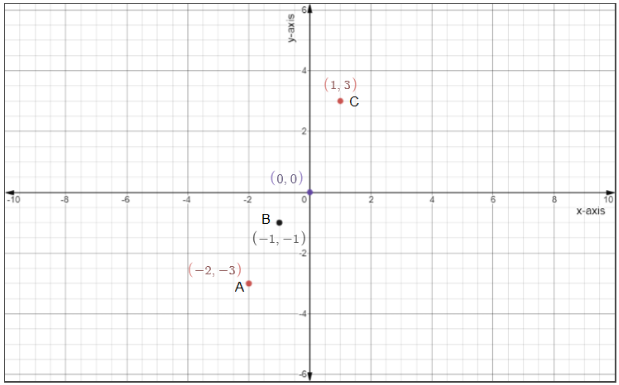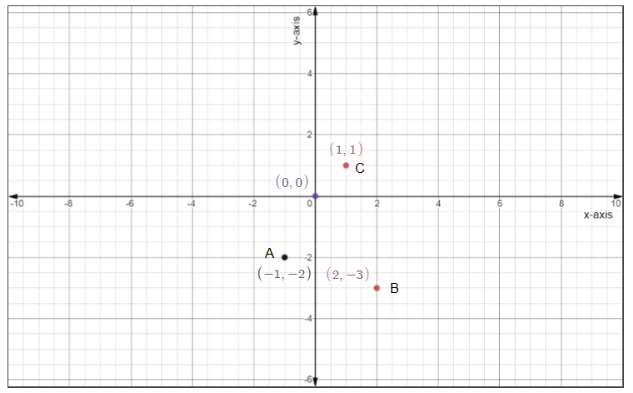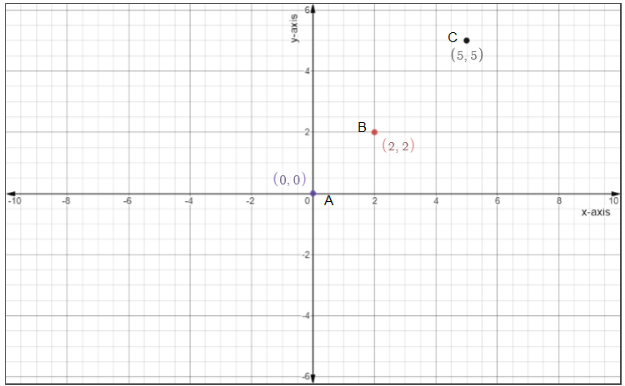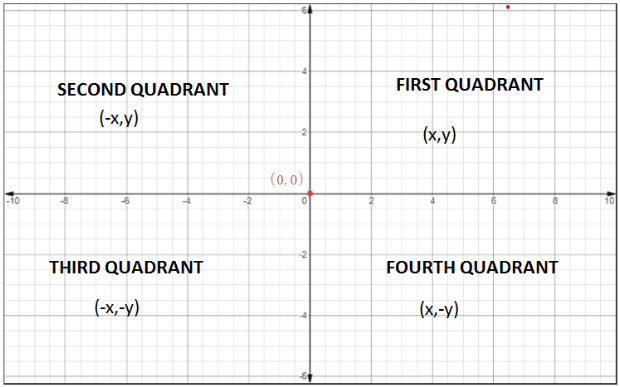
Plot the following points and check whether they are collinear or not:
A) $\left( {1,3} \right),\left( { - 1, - 1} \right),\left( { - 2, - 3} \right)$
B) $\left( {1,1} \right),\left( {2, - 3} \right),\left( { - 1, - 2} \right)$
C) $\left( {0,0} \right),\left( {2,2} \right),\left( {5,5} \right)$
Answer
573.3k+ views
Hint: For three points to be collinear means all three points lie on the straight line.
In the Cartesian plane, the horizontal line is the x-axis, and the vertical line is the y-axis. The x-axis and y-axis are perpendicular to each other.
The point where the x-axis and y-axis cut each other is called the origin, $\left( {0,0} \right)$ .
The coordinates of a point of the Cartesian plane is written in the form $\left( {x,y} \right)$.
Figure: Three collinear points
Therefore, Length AB + length BC = Length AC. Try to use this condition to check whether lines are collinear or not.
The length AB or distance between points A and B can be calculated using the distance formula.

Complete step-by-step answer:
Step 1: Distance formula for two points in the cartesian plane.
Let coordinates of a point A is $\left( {{x_1},{y_1}} \right)$ and a point B is $\left( {{x_2},{y_2}} \right)$ .
The distance between points A and B or the length AB is given by
$AB = \sqrt {{{\left( {{x_2} - {x_1}} \right)}^2} + {{\left( {{y_2} - {y_1}} \right)}^2}} $
Step 2: Plot (A)
$\left( {1,3} \right),\left( { - 1, - 1} \right),\left( { - 2, - 3} \right)$

Step 3: Check for collinearity of (A)
Calculating length AB using the distance formula. $A\left( { - 2, - 3} \right);B\left( { - 1, - 1} \right)$
$
AB = \sqrt {{{\left( { - 1 - \left( { - 2} \right)} \right)}^2} + {{\left( { - 1 - \left( { - 3} \right)} \right)}^2}} \\
\Rightarrow \sqrt {{{\left( { - 1 + 2} \right)}^2} + {{\left( { - 1 + 3} \right)}^2}} \\
\Rightarrow \sqrt {{{\left( 1 \right)}^2} + {{\left( 2 \right)}^2}} \\
\Rightarrow \sqrt {1 + 4} \\
\because AB = \sqrt 5 \\
$
Calculating length BC using the distance formula. $B\left( { - 1, - 1} \right);C\left( {1,3} \right)$
\[
BC = \sqrt {{{\left( {1 - \left( { - 1} \right)} \right)}^2} + {{\left( {3 - \left( { - 1} \right)} \right)}^2}} \\
\Rightarrow \sqrt {{{\left( {1 + 1} \right)}^2} + {{\left( {3 + 1} \right)}^2}} \\
\Rightarrow \sqrt {{{\left( 2 \right)}^2} + {{\left( 4 \right)}^2}} \\
\Rightarrow \sqrt {4 + 16} \\
\Rightarrow \sqrt {20} \\
\because BC = 2\sqrt 5 \\
\]
Calculating length AC using the distance formula. $A\left( { - 2, - 3} \right);C\left( {1,3} \right)$
$
AC = \sqrt {{{\left( {1 - \left( { - 2} \right)} \right)}^2} + {{\left( {3 - \left( { - 3} \right)} \right)}^2}} \\
\Rightarrow \sqrt {{{\left( {1 + 2} \right)}^2} + {{\left( {3 + 3} \right)}^2}} \\
\Rightarrow \sqrt {{{\left( 3 \right)}^2} + {{\left( 6 \right)}^2}} \\
\Rightarrow \sqrt {9 + 36} \\
\Rightarrow \sqrt {9\left( {1 + 4} \right)} \\
\because AC = 3\sqrt 5 \\
$
AB + BC = $AB + BC = \sqrt 5 + 2\sqrt 5 = 3\sqrt 5 = AC$
$\because $hence, points A, B, C are collinear.
Step 4: Plot (B)
$\left( {1,1} \right),\left( {2, - 3} \right),\left( { - 1, - 2} \right)$

Step 5: Check for collinearity of (B)
Calculating length AB using the distance formula. $A\left( { - 1, - 2} \right);B\left( {2, - 3} \right)$
$
AB = \sqrt {{{\left( {2 - \left( { - 1} \right)} \right)}^2} + {{\left( { - 3 - \left( { - 2} \right)} \right)}^2}} \\
\Rightarrow \sqrt {{{\left( {2 + 1} \right)}^2} + {{\left( { - 3 + 2} \right)}^2}} \\
\Rightarrow \sqrt {{{\left( 3 \right)}^2} + {{\left( { - 1} \right)}^2}} \\
\Rightarrow \sqrt {9 + 1} \\
\because AB = \sqrt {10} \\
$
Calculating length BC using the distance formula. $B\left( {2, - 3} \right);C\left( {1,1} \right)$
\[
BC = \sqrt {{{\left( {1 - 2} \right)}^2} + {{\left( {1 - \left( { - 3} \right)} \right)}^2}} \\
\Rightarrow \sqrt {{{\left( { - 1} \right)}^2} + {{\left( {1 + 3} \right)}^2}} \\
\Rightarrow \sqrt {{{\left( { - 1} \right)}^2} + {{\left( 4 \right)}^2}} \\
\Rightarrow \sqrt {1 + 16} \\
\because BC = \sqrt {17} \\
\]
Calculating length AC using the distance formula. $A\left( { - 1, - 2} \right);C\left( {1,1} \right)$
$
AC = \sqrt {{{\left( {1 - \left( { - 1} \right)} \right)}^2} + {{\left( {1 - \left( { - 2} \right)} \right)}^2}} \\
\Rightarrow \sqrt {{{\left( {1 + 1} \right)}^2} + {{\left( {1 + 2} \right)}^2}} \\
\Rightarrow \sqrt {{{\left( 2 \right)}^2} + {{\left( 3 \right)}^2}} \\
\Rightarrow \sqrt {4 + 9} \\
\because AC = \sqrt {13} \\
$
AB + BC = $AB + BC = \sqrt {10} + \sqrt {17} \ne AC = \sqrt {13} $
$\because $hence, points A, B, C are not collinear.
Step 6: Plot (C)
$\left( {0,0} \right),\left( {2,2} \right),\left( {5,5} \right)$

Step 7: Check for collinearity of (C)
Calculating length AB using the distance formula. $A\left( {0,0} \right);B\left( {2,2} \right)$
$
AB = \sqrt {{{\left( {2 - 0} \right)}^2} + {{\left( {2 - 0} \right)}^2}} \\
\Rightarrow \sqrt {{{\left( 2 \right)}^2} + {{\left( 2 \right)}^2}} \\
\Rightarrow \sqrt {4 + 4} \\
\because AB = 2\sqrt 2 \\
$
Calculating length BC using the distance formula. $B\left( {2,2} \right);C\left( {5,5} \right)$
\[
BC = \sqrt {{{\left( {5 - 2} \right)}^2} + {{\left( {5 - 2} \right)}^2}} \\
\Rightarrow \sqrt {{{\left( 3 \right)}^2} + {{\left( 3 \right)}^2}} \\
\Rightarrow \sqrt {9 + 9} \\
\because BC = 3\sqrt 2 \\
\]
Calculating length AC using the distance formula. $A\left( {0,0} \right);C\left( {5,5} \right)$
$
AC = \sqrt {{{\left( {5 - 0} \right)}^2} + {{\left( {5 - 0} \right)}^2}} \\
\Rightarrow \sqrt {{{\left( 5 \right)}^2} + {{\left( 5 \right)}^2}} \\
\Rightarrow \sqrt {25 + 25} \\
\because AC = 5\sqrt 2 \\
$
AB + BC = $AB + BC = 2\sqrt 2 + 3\sqrt 2 = 5\sqrt 2 = AC$
$\because $hence, points A, B, C are collinear.
Final answer: (A) and (C) are collinear but (B) is non-collinear.
Note: Distance formula for two points in the 3-dimensional cartesian plane.
Let coordinates of a point A is $\left( {{x_1},{y_1},{z_1}} \right)$ and a point B is $\left( {{x_2},{y_2},{z_2}} \right)$ .
The distance between points A and B or the length AB is given by
$AB = \sqrt {{{\left( {{x_2} - {x_1}} \right)}^2} + {{\left( {{y_2} - {y_1}} \right)}^2} + {{\left( {{z_2} - {z_1}} \right)}^2}} $
The x-axis and y-axis divide the Cartesian plane into four parts, each part is known as a quadrant.
Pictorial representation of quadrants:

In the Cartesian plane, the horizontal line is the x-axis, and the vertical line is the y-axis. The x-axis and y-axis are perpendicular to each other.
The point where the x-axis and y-axis cut each other is called the origin, $\left( {0,0} \right)$ .
The coordinates of a point of the Cartesian plane is written in the form $\left( {x,y} \right)$.
Figure: Three collinear points
Therefore, Length AB + length BC = Length AC. Try to use this condition to check whether lines are collinear or not.
The length AB or distance between points A and B can be calculated using the distance formula.

Complete step-by-step answer:
Step 1: Distance formula for two points in the cartesian plane.
Let coordinates of a point A is $\left( {{x_1},{y_1}} \right)$ and a point B is $\left( {{x_2},{y_2}} \right)$ .
The distance between points A and B or the length AB is given by
$AB = \sqrt {{{\left( {{x_2} - {x_1}} \right)}^2} + {{\left( {{y_2} - {y_1}} \right)}^2}} $
Step 2: Plot (A)
$\left( {1,3} \right),\left( { - 1, - 1} \right),\left( { - 2, - 3} \right)$

Step 3: Check for collinearity of (A)
Calculating length AB using the distance formula. $A\left( { - 2, - 3} \right);B\left( { - 1, - 1} \right)$
$
AB = \sqrt {{{\left( { - 1 - \left( { - 2} \right)} \right)}^2} + {{\left( { - 1 - \left( { - 3} \right)} \right)}^2}} \\
\Rightarrow \sqrt {{{\left( { - 1 + 2} \right)}^2} + {{\left( { - 1 + 3} \right)}^2}} \\
\Rightarrow \sqrt {{{\left( 1 \right)}^2} + {{\left( 2 \right)}^2}} \\
\Rightarrow \sqrt {1 + 4} \\
\because AB = \sqrt 5 \\
$
Calculating length BC using the distance formula. $B\left( { - 1, - 1} \right);C\left( {1,3} \right)$
\[
BC = \sqrt {{{\left( {1 - \left( { - 1} \right)} \right)}^2} + {{\left( {3 - \left( { - 1} \right)} \right)}^2}} \\
\Rightarrow \sqrt {{{\left( {1 + 1} \right)}^2} + {{\left( {3 + 1} \right)}^2}} \\
\Rightarrow \sqrt {{{\left( 2 \right)}^2} + {{\left( 4 \right)}^2}} \\
\Rightarrow \sqrt {4 + 16} \\
\Rightarrow \sqrt {20} \\
\because BC = 2\sqrt 5 \\
\]
Calculating length AC using the distance formula. $A\left( { - 2, - 3} \right);C\left( {1,3} \right)$
$
AC = \sqrt {{{\left( {1 - \left( { - 2} \right)} \right)}^2} + {{\left( {3 - \left( { - 3} \right)} \right)}^2}} \\
\Rightarrow \sqrt {{{\left( {1 + 2} \right)}^2} + {{\left( {3 + 3} \right)}^2}} \\
\Rightarrow \sqrt {{{\left( 3 \right)}^2} + {{\left( 6 \right)}^2}} \\
\Rightarrow \sqrt {9 + 36} \\
\Rightarrow \sqrt {9\left( {1 + 4} \right)} \\
\because AC = 3\sqrt 5 \\
$
AB + BC = $AB + BC = \sqrt 5 + 2\sqrt 5 = 3\sqrt 5 = AC$
$\because $hence, points A, B, C are collinear.
Step 4: Plot (B)
$\left( {1,1} \right),\left( {2, - 3} \right),\left( { - 1, - 2} \right)$

Step 5: Check for collinearity of (B)
Calculating length AB using the distance formula. $A\left( { - 1, - 2} \right);B\left( {2, - 3} \right)$
$
AB = \sqrt {{{\left( {2 - \left( { - 1} \right)} \right)}^2} + {{\left( { - 3 - \left( { - 2} \right)} \right)}^2}} \\
\Rightarrow \sqrt {{{\left( {2 + 1} \right)}^2} + {{\left( { - 3 + 2} \right)}^2}} \\
\Rightarrow \sqrt {{{\left( 3 \right)}^2} + {{\left( { - 1} \right)}^2}} \\
\Rightarrow \sqrt {9 + 1} \\
\because AB = \sqrt {10} \\
$
Calculating length BC using the distance formula. $B\left( {2, - 3} \right);C\left( {1,1} \right)$
\[
BC = \sqrt {{{\left( {1 - 2} \right)}^2} + {{\left( {1 - \left( { - 3} \right)} \right)}^2}} \\
\Rightarrow \sqrt {{{\left( { - 1} \right)}^2} + {{\left( {1 + 3} \right)}^2}} \\
\Rightarrow \sqrt {{{\left( { - 1} \right)}^2} + {{\left( 4 \right)}^2}} \\
\Rightarrow \sqrt {1 + 16} \\
\because BC = \sqrt {17} \\
\]
Calculating length AC using the distance formula. $A\left( { - 1, - 2} \right);C\left( {1,1} \right)$
$
AC = \sqrt {{{\left( {1 - \left( { - 1} \right)} \right)}^2} + {{\left( {1 - \left( { - 2} \right)} \right)}^2}} \\
\Rightarrow \sqrt {{{\left( {1 + 1} \right)}^2} + {{\left( {1 + 2} \right)}^2}} \\
\Rightarrow \sqrt {{{\left( 2 \right)}^2} + {{\left( 3 \right)}^2}} \\
\Rightarrow \sqrt {4 + 9} \\
\because AC = \sqrt {13} \\
$
AB + BC = $AB + BC = \sqrt {10} + \sqrt {17} \ne AC = \sqrt {13} $
$\because $hence, points A, B, C are not collinear.
Step 6: Plot (C)
$\left( {0,0} \right),\left( {2,2} \right),\left( {5,5} \right)$

Step 7: Check for collinearity of (C)
Calculating length AB using the distance formula. $A\left( {0,0} \right);B\left( {2,2} \right)$
$
AB = \sqrt {{{\left( {2 - 0} \right)}^2} + {{\left( {2 - 0} \right)}^2}} \\
\Rightarrow \sqrt {{{\left( 2 \right)}^2} + {{\left( 2 \right)}^2}} \\
\Rightarrow \sqrt {4 + 4} \\
\because AB = 2\sqrt 2 \\
$
Calculating length BC using the distance formula. $B\left( {2,2} \right);C\left( {5,5} \right)$
\[
BC = \sqrt {{{\left( {5 - 2} \right)}^2} + {{\left( {5 - 2} \right)}^2}} \\
\Rightarrow \sqrt {{{\left( 3 \right)}^2} + {{\left( 3 \right)}^2}} \\
\Rightarrow \sqrt {9 + 9} \\
\because BC = 3\sqrt 2 \\
\]
Calculating length AC using the distance formula. $A\left( {0,0} \right);C\left( {5,5} \right)$
$
AC = \sqrt {{{\left( {5 - 0} \right)}^2} + {{\left( {5 - 0} \right)}^2}} \\
\Rightarrow \sqrt {{{\left( 5 \right)}^2} + {{\left( 5 \right)}^2}} \\
\Rightarrow \sqrt {25 + 25} \\
\because AC = 5\sqrt 2 \\
$
AB + BC = $AB + BC = 2\sqrt 2 + 3\sqrt 2 = 5\sqrt 2 = AC$
$\because $hence, points A, B, C are collinear.
Final answer: (A) and (C) are collinear but (B) is non-collinear.
Note: Distance formula for two points in the 3-dimensional cartesian plane.
Let coordinates of a point A is $\left( {{x_1},{y_1},{z_1}} \right)$ and a point B is $\left( {{x_2},{y_2},{z_2}} \right)$ .
The distance between points A and B or the length AB is given by
$AB = \sqrt {{{\left( {{x_2} - {x_1}} \right)}^2} + {{\left( {{y_2} - {y_1}} \right)}^2} + {{\left( {{z_2} - {z_1}} \right)}^2}} $
The x-axis and y-axis divide the Cartesian plane into four parts, each part is known as a quadrant.
Pictorial representation of quadrants:

Recently Updated Pages
Master Class 12 Business Studies: Engaging Questions & Answers for Success

Master Class 12 Economics: Engaging Questions & Answers for Success

Master Class 12 English: Engaging Questions & Answers for Success

Master Class 12 Maths: Engaging Questions & Answers for Success

Master Class 12 Social Science: Engaging Questions & Answers for Success

Master Class 12 Chemistry: Engaging Questions & Answers for Success

Trending doubts
Which places in India experience sunrise first and class 9 social science CBSE

Fill the blanks with the suitable prepositions 1 The class 9 english CBSE

Write the 6 fundamental rights of India and explain in detail

Difference Between Plant Cell and Animal Cell

What is pollution? How many types of pollution? Define it

What is the full form of pH?




